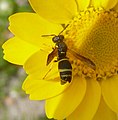Ficheiro:Odynerus spinipes^ Vespidae. See parasite note - Flickr - gailhampshire.jpg

Tamaño desta vista previa: 519 × 600 píxeles. Outras resolucións: 208 × 240 píxeles | 415 × 480 píxeles | 654 × 756 píxeles.
Ficheiro orixinal (654 × 756 píxeles; tamaño do ficheiro: 166 kB; tipo MIME: image/jpeg)
Historial do ficheiro
Prema nunha data/hora para ver o ficheiro tal e como estaba nese momento.
| Data/Hora | Miniatura | Dimensións | Usuario | Comentario | |
|---|---|---|---|---|---|
| actual | 14 de outubro de 2017 ás 13:21 |  | 654 × 756 (166 kB) | Chiswick Chap | Cropped 31 % horizontally and 22 % vertically using CropTool with precise mode. |
| 8 de xullo de 2016 ás 21:48 |  | 952 × 972 (183 kB) | Josve05a | == {{int:filedesc}} == {{Information |Description=Most Strepsiptera (also known as twisted-wing parasites) live as internal parasites of bees, wasps, grasshoppers, leafhoppers, and other members of the order Hemiptera. Only a few species that parasit... |
Uso do ficheiro
A seguinte páxina usa este ficheiro:
Uso global do ficheiro
Os seguintes wikis empregan esta imaxe:
- Uso en en.wikipedia.org
- Uso en fa.wikipedia.org
- Uso en la.wikipedia.org
- Uso en tr.wikipedia.org